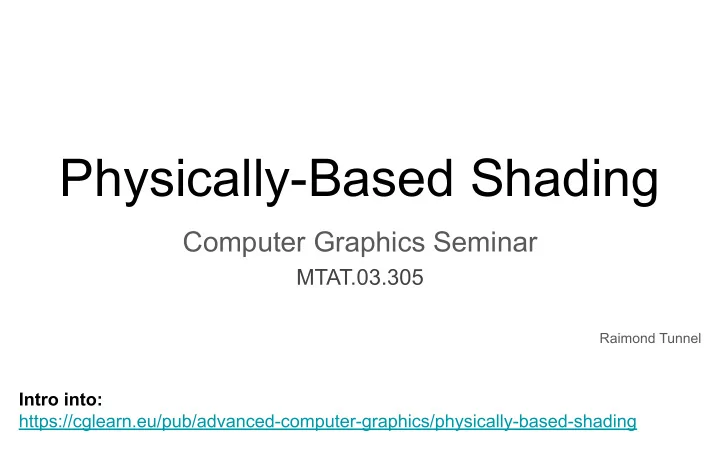

Physically-Based Shading Computer Graphics Seminar MTAT.03.305 Raimond Tunnel Intro into: https://cglearn.eu/pub/advanced-computer-graphics/physically-based-shading
Phong’s Lighting Model
Phong’s Lighting Model
Phong’s Lighting Model
Phong’s Lighting Model
Specular Not just a highlight vs
Specular Not just a highlight vs
Specular Not just a highlight vs
Diffuse* Diffuse light should also use the environment. vs
Dielectrics and Metals
Dielectrics pixel
Dielectrics Color comes Dielectrics also from the diffuse have specular!
Metals electron gas pixel
Metals Metals are specular only!
Dielectrics and Metals electrons absorb the complementary wavelengths electron gas absorbs the complementary wavelengths dissipates the energy
Dielectrics and Metals electrons absorb the complementary wavelengths absorbed by the electron gas
Dielectrics and Metals Specify how much light is absorbed / reflected.
Fresnel Amount of light reflected ( ) depends on: 1. Phase velocity of light in the material 2. Angle of incidence
Fresnel 1. Phase velocity of light in the material https://en.wikipedia.org/wiki/File:Wave_group.gif
Fresnel 1. Phase velocity of light in the material Speed of light in a vacuum Index of refraction Phase velocity of light in the material
Fresnel 1. Phase velocity of light in the material ~n material Air 1.00 Water 1.33 Window glass 1.52 Sapphire 1.76 Diamond 2.42 https://en.wikipedia.org/wiki/List_of_refractive_indices
Fresnel 2. Angle of incidence Grazing angle: Ricochets off Steep angle: Penetrates the material
Fresnel Schlick’s approximation air material
Fresnel Schlick’s approximation air This works well material only for dielectrics!
Fresnel ~1.62 Polystyrene (common plastic) ~1.58 visible light https://refractiveindex.info/?shelf=3d&book=plastics&page=ps
Fresnel ~8.46 Aluminium ~4.57 Complex IoR. Changes a lot. ~2.31 ~0.43 visible light https://refractiveindex.info/?shelf=3d&book=metals&page=aluminium
Fresnel Brass ~4.42 Complex IoR. Changes a lot. ~1.82 ~0.46 ~1.50 visible light https://refractiveindex.info/?shelf=3d&book=metals&page=brass
Fresnel The value is the reflected spectra at 0°. We can specify it ourselves instead of relying on the calculation with the index of refraction.
Fresnel material dielectrics gold aluminium copper iron https://80.lv/articles/the-newbies-pbr-cheat-sheet/
Fresnel Dielectrics Metals diffusely scattered back out absorbed by the electron gas in material color
Fresnel Metals: in material color Dielectrics: uniform
Fresnel All objects are more reflective at grazing angles. 20% 40% 60% 80%
Fresnel
Dielectrics and Metals color white scattered light source color color black tinted absorbed copper
Dielectrics and Metals – is the material metal (1) or dielectric (0) – color for metals, ~0.03 for dielectrics
Interesting Links https://psgraphics.blogspot.com/2020/03/fresnel-equations-schlick-approximation.ht ml - Peter Shirley, 13.03.2020 https://otik.zcu.cz/bitstream/11025/11214/1/Lazanyi.pdf - Lazanyi, 2005, a way to use Schlick with complex number IoR. https://www.scratchapixel.com/lessons/3d-basic-rendering/introduction-to-shading/re flection-refraction-fresnel - Reflection, Refraction (Transmission) and Fresnel
In Game Engines and Graphics Libraries What tools are these?
Microfacets
Microfacets Surfaces are not generally microscopically flat! pixel pixel
Microfacets The microfacet function
Microfacets The microfacet function We look at all the directions on a hemisphere for microfacet normals
Microfacets The microfacet function Given one microsurface with normal , how much light it radiates The material (BRDF) of one microsurface.
Microfacets The microfacet function The total area of the microsurfaces that are with the normal . The distribution term.
V-cavities: Microfacets The microfacet function masking shadowing What percentage of the microsurfaces are illuminated? The geometry term.
Microfacets The microfacet function Contribution into the viewer’s pixel. (projected area)
Microfacets The microfacet function Contribution of the incoming light. (projected area)
Microfacets Usually that integral is difficult to solve analytically! And you do not want to do some big sum in the fragment shader to approximate it…
Oren-Nayar (1994) σ = 1.4
Oren-Nayar (1994) A numerical approximation for: – ideal diffuse reflector – V-cavities – Gaussian: macrosurface normal, user parameter
Oren-Nayar (1994) – the color
Oren-Nayar (1994) Authors were inspired by previous research about shading the moon (eg by Ernst Öpik in 1924). http://kevin-george-2n3x.squarespace.com/blog/2014/5/25/shading-diffuse-models
Cook-Torrance (1982) An analytical solution for: – ideal specular reflector – V-cavities – Beckmann: macrosurface normal, user parameter
Cook-Torrance (1982) (Beckmann distribution) The integral was analytically converted to a finite equation!
Cook-Torrance (1982) red plastic aluminium
Metallic-Roughness Workflow
Links, examples and further materials in: https://cglearn.eu/pub/advanced-computer-graphics/ physically-based-shading Thanks
Recommend
More recommend